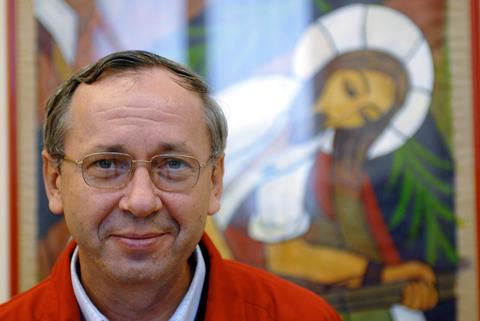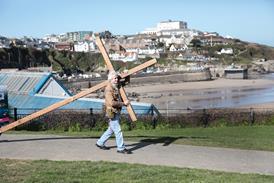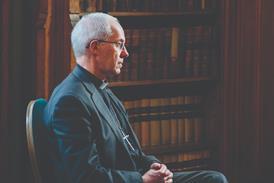The disgraced Jesuit has already been excommunicated by the Catholic Church, following sexual infidelity. Now, as the Church awaits the findings of a new abuse investigation, survivors are calling for his once-popular mosaics to be taken down

Slovenian Catholic priest Fr Marko Rupnik, 69, is currently under investigation by the Vatican after being accused by multiple women and at least one man of historic sexual, spiritual and psychological abuse.
Fr Rupnik is one of the most popular artists in the Catholic Church. He founded the religious art community, Centro Aletti, in Rome in 1991, which produces murals and mosaics adorning many Catholic churches and shrines throughout the world. These include chapels and shrines at the Vatican and over 100 other places, including Fatima and the iconic Marian shrine in Lourdes.
Wasn’t he already excommunicated?
Yes, following credible allegations, the priest was excommunicated in 2020 by the Vatican for “absolution of an accomplice.” This refers to a situation where a priest has sex with someone and absolves this person during confession. However, this excommunication was soon removed, the reason given that Fr Rupnik had repented, which many disputed.
In June 2023, Fr Rupnik was expelled from the Jesuit Order to which he belonged for failing to obey restrictions placed on him. Four months later, Pope Francis reopened the case against Fr Rupnik regarding the sexual, spiritual and psychological allegations.
What has happened since then?
Harrowing stories have emerged. In February, Gloria Branciani, 59, explained how she met Fr Rupnik when she was a 21-year-old medical student at the Loyola Community, Slovenia, where Fr Rupnik was the spiritual director. She said that Fr Rupnik tried to persuade her to have sex with him and another nun in order to “reflect the Trinity.”
It has been almost a year since the latest investigation began. When will it conclude?
When asked about the timeline earlier this summer, Irish Monsignor John Joseph Kennedy said the “delicate” investigation was “at a fairly advanced stage.” But he wouldn’t be drawn on specifics.
He’s decorated prominent Catholic churches around the world. How have abuse survivors responded?
Sara Larson, executive director of Awake, an American survivor support group, said: “The continued use of Rupnik’s art is incredibly hurtful to many abuse survivors.”
LOUDFence UK is a group which aims to give survivors, the entire Church and wider society a voice. Director Antonia Sobocki, from Cumbria, has long called for the complete removal of Fr Rupnik’s artwork.
“Everyone is stalling for time, saying we are waiting for the end of the canonical process,” she said. “Rape art is not only replaceable, it must be removed.”
Sobocki is particularly keen for the removal of Fr Rupnik’s works of art in Lourdes. Lourdes is a special place of pilgrimage for Catholics, who believe that Mary appeared several times to a young peasant girl, Bernadette Soubirois, in 1858. Lourdes is associated with healing for the poor, vulnerable and abuse victims.
Sobocki said: “Lourdes is a place dedicated to healing and lots of victims of sexual abuse [who] go there looking specifically for healing. That is a colossal psychological barrier that prevents them from going to Lourdes [due to the artwork].”
Does everyone want the artwork removed?
No. Papal biographer Austen Ivereigh said: “Rupnick (sic) stays on my wall. I don’t approve of what he has done, but his are works of grace, and I don’t want to reject grace.”
Last week, Maria Campatelli from the Centro Aletti launched a stinging attack on what she called “so-called ‘cancel culture’”.
“The removal of a work of art ought never to be thought of as a punishment or a cure,” Campatelli wrote in a letter to the Friends of the Aletti Center. “While pastoral care for suffering persons is of course necessary, this cannot become a justification for the removal or covering of works of art, for doing so creates other sufferings.”
Campatelli added that “justice cannot be pursued by means of injustice”, referring to the principal of innocent until proven guilty. It would therefore be wrong to remove artwork before a verdict is declared, she argued. “If we forget this, we arrive at the paradox of issuing a sentence without possibility of appeal before the judgment has been rendered, and asking for the sacrifice of a kind of scapegoat on behalf of victims, taken generically.”
What has Rupnik said?
Campatelli has reported that Rupnik has “always firmly denied” the allegations.
Is action to remove the artwork happening already?
In some places, yes. In July, Catholic fraternity group the Knights of Columbus placed brown paper over a number of Rupnik’s mosaics at Washington’s St. John Paul II National Shrine.
Bishop Jean-Marc Micas of Tarbes and Lourdes, France, said in July that Father Rupnik’s mosaics at the Basilica of Our Lady of the Rosary at the Lourdes shrine will no longer be illuminated. This hasn’t satisfied the survivor groups who are calling for a complete ban as they wait for the Vatican report.
How will this impact the Catholic church?
Antonia Sobocki is hoping the final report will call for the removal or covering up of all Rupnik’s artwork. However, she believes that, if this does not happen, the impact on the victims will be significant and that it “will undermine the moral authority of the Church.”
Pope Francis has spoken of “getting tough” on abusers. In March, he said abuse victims must be “at the centre” of everything, and that simply “asking for forgiveness” is insufficient. However, the Catholic church has long struggled to respond effectively to the scourge of abuse and many criticise the Church for a lack of transparency.
Survivors hope that firm action will be taken against Fr Rupnik and that a zero-tolerance culture will begin to emerge around abuse.


































No comments yet